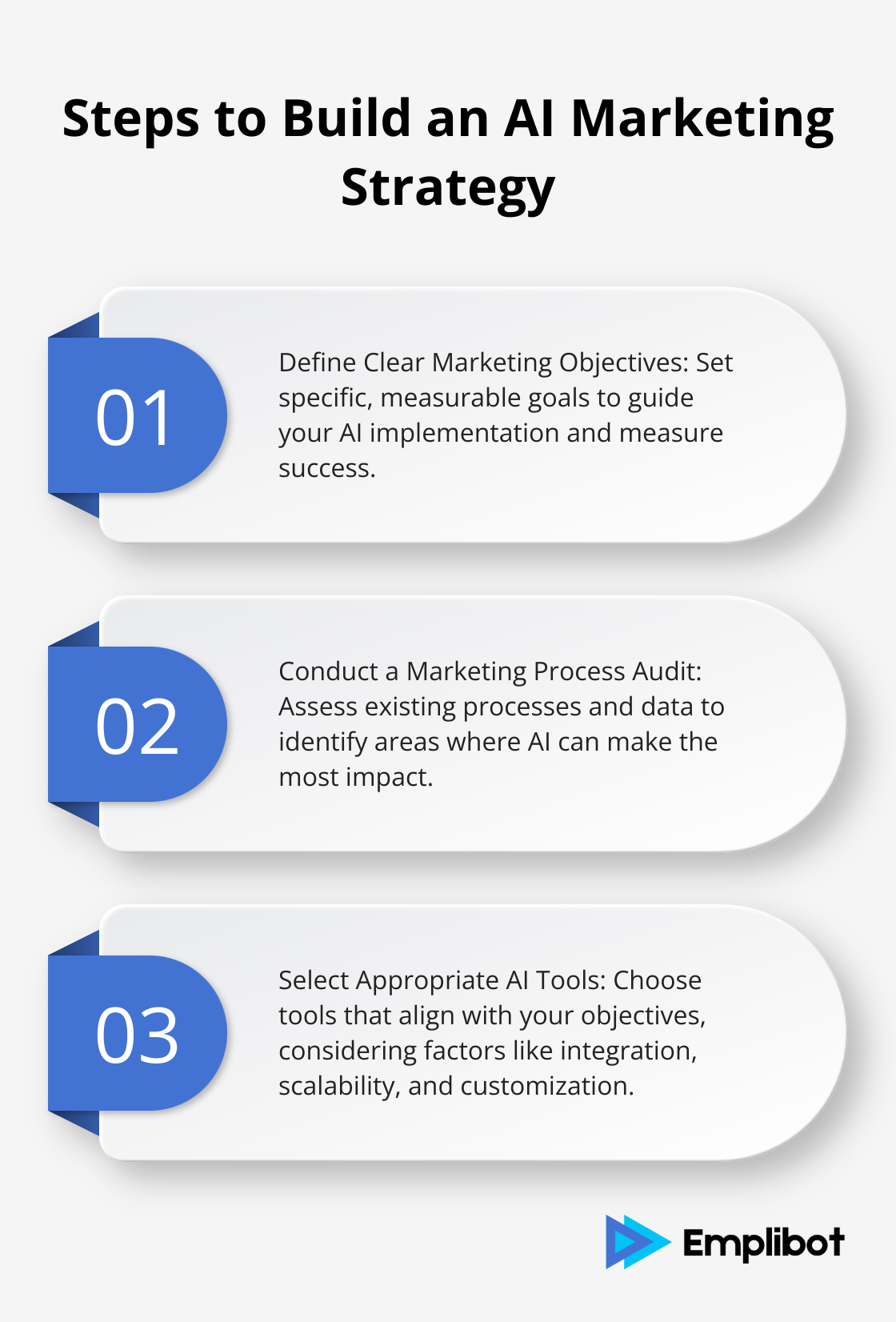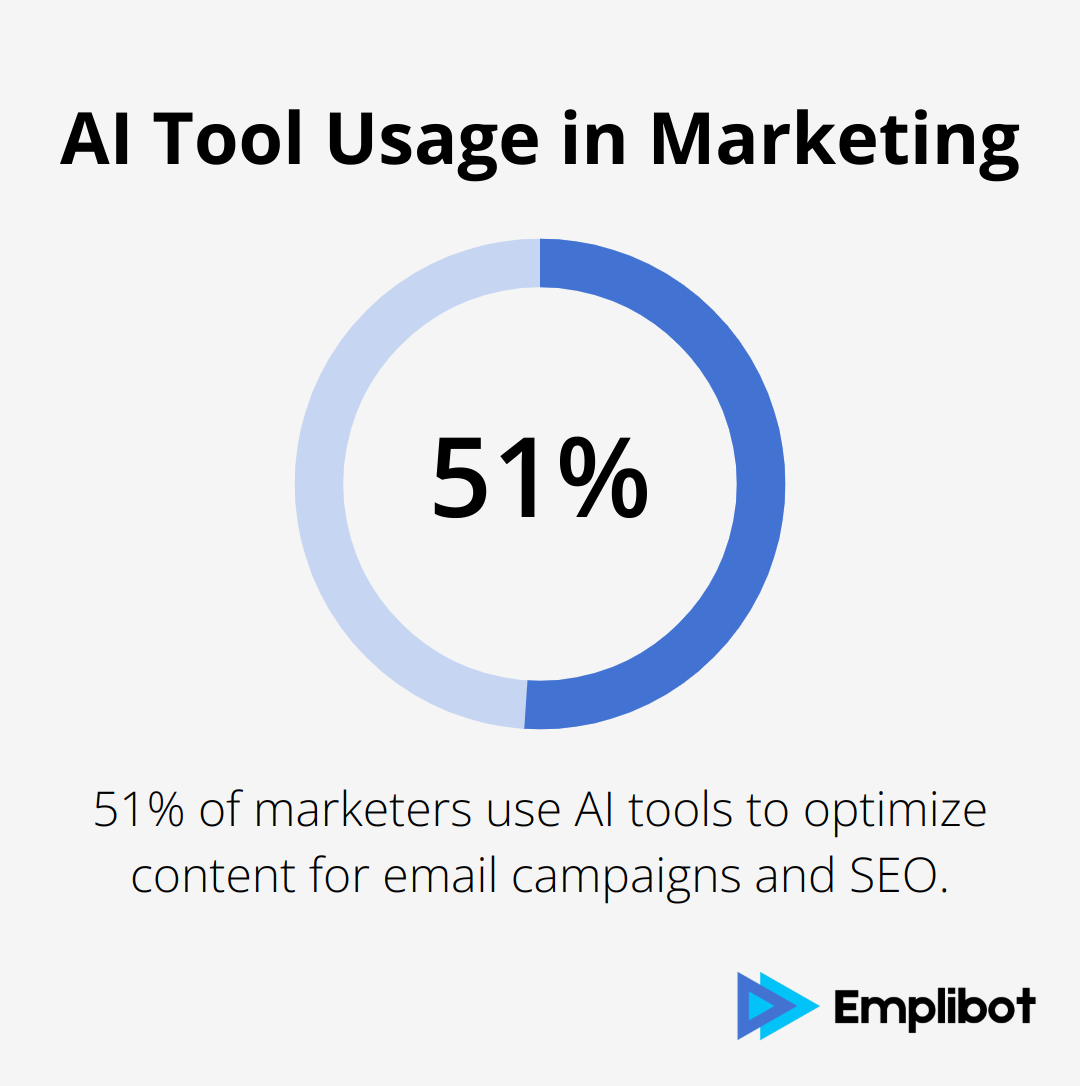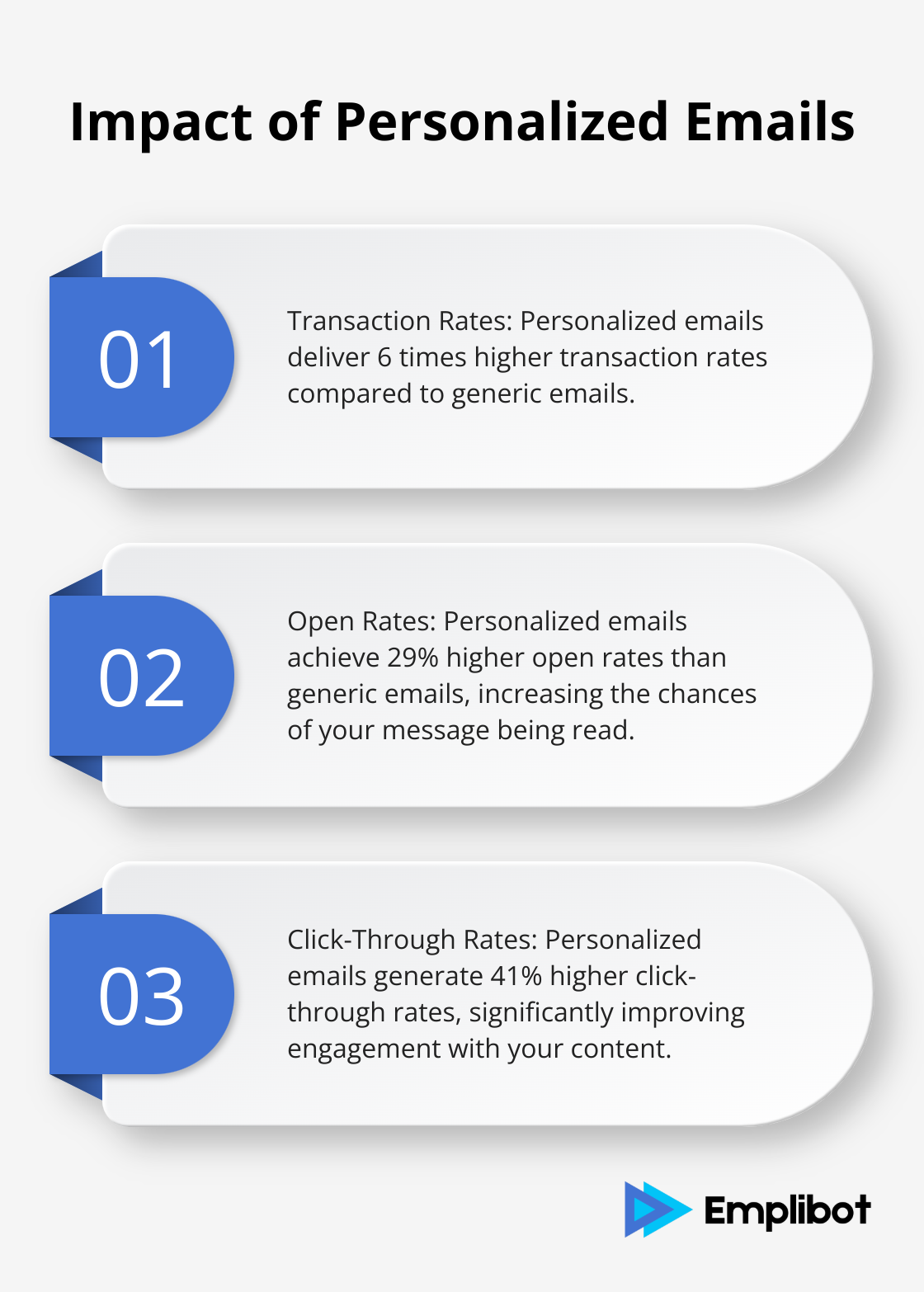AI is revolutionizing marketing, offering unprecedented opportunities for businesses to connect with their audience. At Emplibot, we’ve seen firsthand how AI-driven strategies can transform marketing efforts.
This blog post will guide you through creating an effective AI marketing plan, from understanding key technologies to implementing AI across various channels. We’ll also introduce you to our AI marketing plan generator, designed to streamline your planning process.
What is AI-Driven Marketing?
AI-driven marketing revolutionizes how businesses connect with their customers. It uses artificial intelligence to analyze data, predict trends, and automate marketing tasks. This approach enables marketers to make more informed decisions and create highly personalized campaigns.
Machine Learning: The Engine of Predictive Marketing
Machine learning, a subset of AI, significantly impacts marketing. It processes vast amounts of customer data to identify patterns and predict future behaviors. Netflix, for example, uses machine learning algorithms to recommend shows based on viewing history, which keeps users engaged and reduces churn.
Natural Language Processing: Decoding Customer Insights
Natural Language Processing (NLP) is another key AI technology in marketing. It helps businesses understand and respond to customer queries, analyze sentiment in social media posts, and even generate content. Grammarly uses NLP to improve writing quality, which is essential for creating compelling marketing copy.
AI-Powered Task Automation
AI excels at automating repetitive tasks, which allows marketers to focus on strategy and creativity. Email marketing platforms like Mailchimp use AI to optimize send times and personalize content, resulting in higher open rates and conversions.
The Benefits of AI in Marketing Strategy
Implementing AI in your marketing strategy can lead to significant advantages. It increases efficiency, improves targeting, and enhances the customer experience. AI automates content creation and distribution across multiple platforms, which saves time and enables consistent brand messaging. This is particularly useful for businesses looking to maintain a strong online presence across various channels.
As we move forward, it’s clear that AI-driven marketing is not just a trend, but a necessary evolution in the field. The next section will explore how to develop an effective AI-driven marketing strategy, taking into account your specific business goals and current processes.
How to Build Your AI Marketing Strategy
Define Clear Marketing Objectives
Start your AI marketing strategy by setting specific, measurable goals. Do you want to increase website traffic by 50% in six months? Or boost customer retention rates by 25% over the next year? Make your objectives concrete and time-bound. This clarity will guide your AI implementation and help you measure success.
Conduct a Marketing Process Audit
Take stock of your existing marketing processes and data before implementing AI. Identify areas where you struggle or spend excessive time. For instance, if content creation is a bottleneck, AI tools can automate this process, freeing up your team for strategic tasks. Also, assess the quality and quantity of your data. AI thrives on data, so ensure you have robust data collection and management systems in place.
Select Appropriate AI Tools
With clear objectives and a solid understanding of your current processes, you can now choose the right AI tools. There’s a wide range of options available, from content creation platforms to predictive analytics tools. When evaluating tools, consider factors like ease of integration with your existing systems, scalability, and the level of customization offered. Don’t forget to factor in the learning curve for your team and the availability of support from the tool provider.
Develop an Implementation Roadmap
Create a detailed plan for integrating AI into your marketing operations. This should include timelines, resource allocation, and specific milestones. Start with low-hanging fruit – areas where AI can quickly demonstrate value. For instance, you might begin with AI-powered content creation and gradually move to more complex applications like predictive customer analytics.
Include training for your team in your roadmap. The success of your AI strategy depends largely on how well your team can leverage these new tools.

Now that you have a solid foundation for your AI marketing strategy, it’s time to explore how to implement AI across various marketing channels for maximum impact.
How AI Transforms Your Marketing Channels
AI-Powered Content Creation
51% of marketers use AI tools to optimize their content for email campaigns and search engine optimization (SEO). These tools generate blog posts, social media updates, and video scripts faster than human writers. GPT-3 based tools create entire articles from simple prompts, while platforms like Jasper.ai specialize in marketing copy.
AI-generated content should serve as a starting point, not the final product. Human editors must review and refine this content to align with brand voice and meet quality standards. This hybrid approach boosts content production while maintaining authenticity.

Email Marketing Personalization at Scale
AI elevates email marketing personalization to new heights. Machine learning algorithms analyze subscriber behavior, preferences, and engagement patterns to tailor email content, subject lines, and send times for each recipient. Personalized emails deliver 6x higher transaction rates, 29% higher open rates, and 41% higher click-through rates compared to generic emails.

Tools like Seventh Sense use AI to determine the optimal send time for each subscriber, increasing open rates by up to 30%. Platforms like Phrasee use natural language processing to generate and optimize email subject lines, boosting click-through rates by up to 37%.
Social Media Impact Maximization
AI revolutionizes social media marketing through automated posting schedules, engagement metric analysis, and content generation. Tools powered by machine learning analyze trending topics, create relevant content, and determine the best times to post for maximum engagement.
For advertising, AI-powered platforms like Albert.ai autonomously manage social media ad campaigns, adjusting bids and budgets in real-time based on performance data. This level of automation and optimization leads to significant improvements in ROI.
Precision Targeting with AI-Powered Segmentation
AI processes vast amounts of data, making it invaluable for customer segmentation and targeting. Machine learning algorithms identify complex patterns in customer behavior, demographics, and purchase history to create highly specific segments.
Dynamic Yield uses AI to create real-time customer segments based on browsing behavior, allowing for instant personalization of website content and product recommendations. This level of targeting increases conversion rates.
Final Thoughts
Creating an AI-driven marketing plan transforms marketing efforts, enabling unprecedented personalization and efficiency across various channels. A strategic approach involves defining clear objectives, assessing current processes, and selecting appropriate AI tools that align with specific goals. Continuous learning and adaptation prove essential in the rapidly evolving field of AI marketing, requiring regular performance evaluations and strategy adjustments.
The future of AI in marketing promises even more significant advancements, including sophisticated natural language processing and enhanced predictive analytics. These developments will further enhance the capabilities of marketers, offering exciting possibilities for more effective campaigns. An AI marketing plan generator can streamline efforts by automating tasks from content creation to distribution, significantly reducing time and resource requirements.
AI should not replace human creativity but enhance it. The combination of AI power with human expertise creates marketing strategies that are more effective and engaging than ever before. We encourage you to explore AI-driven marketing tools and discover how they can elevate your marketing efforts to new heights.

